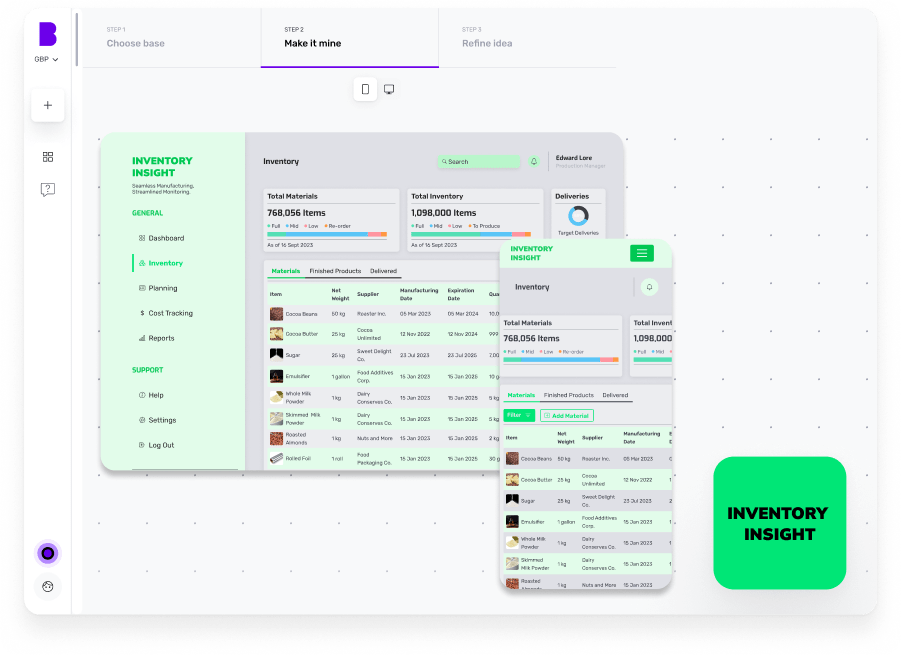Modern technologies like composable software platforms and no-code development have changed the way software is built. They’ve not only made building software faster but more accessible as you don’t need to have technical expertise.
However, despite these advancements, software development is far from risk-free. Challenges like technical complexities, project delays, user dissatisfaction and even legal risks can still jeopardise your project’s success.
In fact, 20% of businesses fail in the first year, 50% within 5 years and 65% within 10 years. One of the main reasons behind them is underestimating the risks associated with software development. Therefore, it’s important to understand these risks and have a clear strategy to mitigate them to ensure the long-term success and growth of your business.
In this blog, we’ll explore the most common risks faced during software development and how you can avoid them.
Let’s dive in 👇
What are software development risks?
Software development risks are challenges that threaten the successful completion of a project. These include technical issues, unclear requirements, unrealistic timelines, resource constraints and changing priorities. Identifying and managing these risks early ensures smoother execution, minimises delays and enhances the chances of delivering a successful product.
7 common risks in software development
1 - Requirements related risks
When planning a software project, it's easy to fall into the trap of wanting to include every possible feature. While this ambition may seem like a way to create a robust product, it often introduces unnecessary challenges.
This generally happens when there’s no clarity on project goals or performance criteria.
Impact of this risk
The impact of such risks can be huge. Development timelines may stretch beyond expectations, costs can spiral out of control and debugging issues becomes more challenging.
Additionally, overly feature-packed software often sacrifices user-friendliness, frustrating end users. Short-term workarounds to manage these issues can also increase technical debt, creating long-term maintenance problems.
How to avoid
To mitigate these risks, it’s crucial to stay focused on solving a core user problem. Instead of trying to address every possible need, identify the primary goal of your software and stick to it. Anything outside of this scope should be deferred.
One way to do it is by building a Minimum Viable Product (MVP). By focusing only on the most essential features, an MVP keeps the project manageable and provides early feedback from users, without overwhelming the development process.
2 - Ineffective project management
Project management plays a critical role in the success of any software development project. When it's done poorly, the consequences can ripple across every stage of development. Ineffective project management can show up as weak planning, unclear communication, inefficient use of resources and inadequate monitoring of progress
Impact of this risk
The impacts of ineffective project management are often severe. Missed deadlines become common, budgets spiral out of control and the quality of the software suffers. Beyond these operational challenges, ineffective management can strain team relationships and erode stakeholder trust. In worst-case scenarios, it can even result in a project's complete failure.
How to mitigate
To avoid these pitfalls, a skilled project manager is essential. An experienced project manager not only brings technical knowledge but also strong leadership skills to guide teams through challenges.
They help anticipate risks, prioritise tasks effectively and keep the project on track by fostering collaboration among stakeholders.
Additionally, adopting Agile project management methodologies, like Scrum or Kanban, can further enhance project outcomes. Agile emphasises breaking work into manageable chunks and allows teams to respond to changing requirements early.
3 - Inexperienced development team
In software development, it’s not just about coding — it’s about having the right combination of technical skills, domain knowledge and soft skills to deliver a successful product. When a software developer lacks experience in any of these areas, it can create significant risks for the project. From coding errors to poor decision-making, inexperience can quickly derail progress.
Impact of this risk
The impact of an inexperienced developer on a project can be wide-ranging. For example, if technical expertise is lacking, the quality of the software may suffer, with bugs and inefficiencies creeping into the final product.
This can lead to missed deadlines, delayed launches and poor resource management. Ultimately, this can hurt your bottom line and lead to lost opportunities.
How to avoid
To minimise these risks, it’s essential to thoroughly assess the technical skills of the software developer. By comparing their expertise with the requirements of the project, you can identify skill gaps early. If any gaps are found, you should ask for bringing in more experienced developers to support the project.
Another way to avoid the risk of inexperience is to hire experienced software development vendors like Builder.ai. Working with a proven vendor who has a strong track record in the industry can help guide the project more effectively. Their expertise ensures the team is on the right path, minimising common risks and improving the chances of success.
4 - Improper security measures
In the rush to deliver functional, user-friendly software quickly, security can sometimes be treated as an afterthought. However, neglecting security during development can introduce significant risks.
Weak coding practices, insufficient data protection and improper user access control can all open the door to security threats. Additionally, relying on risky external integrations, neglecting regular updates and lacking a proper plan for handling security breaches further exacerbate the problem.
Impact of this risk
The impact of not implementing proper security measures can be severe. Data breaches, unauthorised access and loss of sensitive information can cause irreparable damage to a company’s reputation. Financial losses from security incidents can be substantial, and user trust can quickly erode, leading to lost customers and long-term damage to brand credibility.
How to avoid
To mitigate these risks, adopting DevSecOps practices is a key strategy. DevSecOps integrates security throughout the software development lifecycle, ensuring that security is not an afterthought but a built-in component. This approach promotes proactive risk management, where the entire team shares responsibility for security, helping to identify and address potential vulnerabilities early.
Another way to safeguard your software is by choosing secure technologies. Opting for platforms and technologies known for their strong security features and active community support helps ensure a more secure foundation for your software. This can significantly reduce the likelihood of attacks and make it easier to maintain secure systems over time.
5 - Neglect of UI/UX design
Focusing too much on technical features without considering the user interface (UI) and user experience (UX) can lead to significant risks in software development. A product with poor UI/UX design can frustrate users, making it difficult to navigate or use, which may result in lower adoption rates and user dissatisfaction.
Impact of this risk
The potential impact of poor UI/UX design is significant. A product with a confusing or frustrating interface can lead to user dissatisfaction, causing users to abandon the app or product. This may result in lower adoption rates, which directly affects revenue and growth.
Furthermore, a poorly designed product can damage the brand’s reputation, as users associate bad experiences with the company behind the software. If the issues are severe, the company may have to spend additional resources on redesigning and remediating the product, adding unnecessary costs to the project.
How to avoid
To avoid these risks, it's crucial to conduct thorough user research. This involves understanding your target users – their preferences, behaviours, pain points and needs. By gathering insights directly from users, you can design an interface that not only meets their expectations but also delights them.
Creating storyboards is another helpful strategy. Storyboarding allows you to visualise the user’s journey as they interact with your software, helping to identify potential pain points or confusing interactions early on. This allows you to make informed decisions about optimising the user experience, ensuring that the final product flows smoothly and is easy to use.
6 - Inadequate testing
Testing is a critical part of the software development process, but it’s often overlooked or rushed, which can lead to serious risks. If testing isn’t integrated into the project plan from the beginning, or if there’s not enough time or resources allocated to it, issues may go unnoticed until the product is already in the hands of users.
Impact of this risk
The impact of inadequate testing can be severe. Software released with bugs, glitches or security vulnerabilities can provide a poor user experience and harm your business's reputation. In some cases, these issues can even lead to costly fixes, delays or security breaches.
How to avoid
To avoid this, it’s important to develop a comprehensive QA test plan that outlines what needs to be tested and how it will be tested. This ensures that no part of the software is overlooked and that the testing process is thorough.
Additionally, adopting automated testing can help streamline the process by handling repetitive tests quickly, freeing up manual testers to focus on more complex scenarios.
7 - Contractual and legal risks
When developing software, ensuring that all legal and contractual obligations are met is essential. Neglecting to address legal risks properly can result in penalties, lawsuits or other legal issues that can derail the project and damage your reputation. Contractual and legal risks in software development arise from issues such as breaches of contract, intellectual property disputes and failure to comply with industry regulations.
Impact of this risk
These risks can lead to costly legal proceedings, delays and financial penalties. For example, disagreements over the project’s scope or deliverables can result in disputes with clients or partners, while failing to comply with relevant regulations can expose the company to legal liability. If not managed correctly, these issues can also cause damage to relationships with clients, government agencies and other stakeholders.
How to avoid
To minimise these risks, it’s important to thoroughly review and negotiate contracts with legal counsel to ensure clarity and protect the company's interests. Clearly define project scope, deliverables and timelines in the contract to prevent misunderstandings or scope creep. Regularly monitor and update contracts as the project evolves, ensuring they reflect any changes in requirements.
It's also helpful to document all communications and agreements with clients and stakeholders, creating a paper trail that can protect you if disputes arise. Implementing a robust change management process can help manage scope changes and keep the project on track. Additionally, consider obtaining professional liability insurance to help mitigate financial risks associated with potential legal issues.
How Builder.ai help you mitigate these risks
Now that you know the risks in software development, there's some great news. Most of these risks can be effectively managed by working with the right partner.
This is where Builder.ai can help you:
- Proven expertise - with years of experience and a robust portfolio across various industries and app types, we know what works.
- AI-powered development - Natasha, our AI-powered Product Manager, streamlines the development process with precision and speed, taking the guesswork out of it.
- Seamless service - our fully managed service means you don't have to worry about the technical details. We handle everything from design to maintenance, allowing you to focus on growing your business.
- Guaranteed pricing - we provide transparent costs upfront, so you know exactly what you're paying for without any surprises.
- Keep your code - you retain ownership of your app's code, giving you full control even after launch.
- Ongoing support - enjoy 1-year of app maintenance to keep your software secure and running smoothly.
Conclusion
Software development is an exciting journey, but it’s not without its challenges. Managing these challenges, however, requires the combined effort of the entire team, including project managers, developers and business leaders.
With this knowledge, you can't only avoid project delays and customer dissatisfaction but also make sure your software development journey is smooth, secure and successful.
If you want a software development partner to help you minimise software development risks, look no further than Builder.ai.
Want to learn more about how Builder.ai helps you do that? Click the banner below to book a call. 👇
Create robust custom software today
100s of businesses trust us to help them scale.
Book a demoBy proceeding you agree to Builder.ai’s privacy policy
and terms and conditions

Stories published by the editorial team at Builder.ai.










 Facebook
Facebook X
X LinkedIn
LinkedIn YouTube
YouTube Instagram
Instagram RSS
RSS


